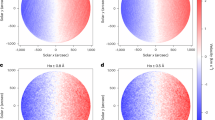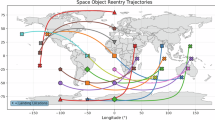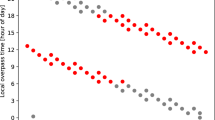Abstract
THE rotational speed of the upper atmosphere at heights near that of the perigee of a satellite can in principle1 be evaluated from the change Δi in the orbital inclination i of the satellite. If Λ denotes the ratio of the atmospheric angular velocity to the Earth's angular velocity, Δi is given2, as a first approximation, by  where ΔT is the change in orbital period, in minutes. In practice the change in inclination, Δi, is often too small to be accurately measurable, and the most accurate values of Λ are likely to be obtained from the orbits for which Δi is largest. We therefore seek orbits which (i) are near-polar and (ii) show a large change in orbital period.
where ΔT is the change in orbital period, in minutes. In practice the change in inclination, Δi, is often too small to be accurately measurable, and the most accurate values of Λ are likely to be obtained from the orbits for which Δi is largest. We therefore seek orbits which (i) are near-polar and (ii) show a large change in orbital period.
This is a preview of subscription content, access via your institution
Access options
Subscribe to this journal
Receive 51 print issues and online access
$199.00 per year
only $3.90 per issue
Buy this article
- Purchase on SpringerLink
- Instant access to full article PDF
Prices may be subject to local taxes which are calculated during checkout
Similar content being viewed by others
References
King-Hele, D. G., Theory of Satellite Orbits in an Atmosphere (Butterworths, London, 1964).
King-Hele, D. G., Plan. Space Sci., 12, 835 (1964).
King-Hele, D. G., and Scott, D. W., Plan. Space Sci., 14, 1339 (1966).
Author information
Authors and Affiliations
Rights and permissions
About this article
Cite this article
KING-HELE, D., SCOTT, D. Rotational Speed of the Upper Atmosphere, from the Orbits of Satellites 1966-51 A, B and C. Nature 213, 1110–1111 (1967). https://doi.org/10.1038/2131110b0
Received:
Published:
Issue date:
DOI: https://doi.org/10.1038/2131110b0
This article is cited by
-
A review of satellite lifetime and orbit decay prediction
Proceedings of the Indian Academy of Sciences Section C: Engineering Sciences (1982)
-
Rotational Speed of the Upper Atmosphere : an Increase with Height above 200 km
Nature (1967)



